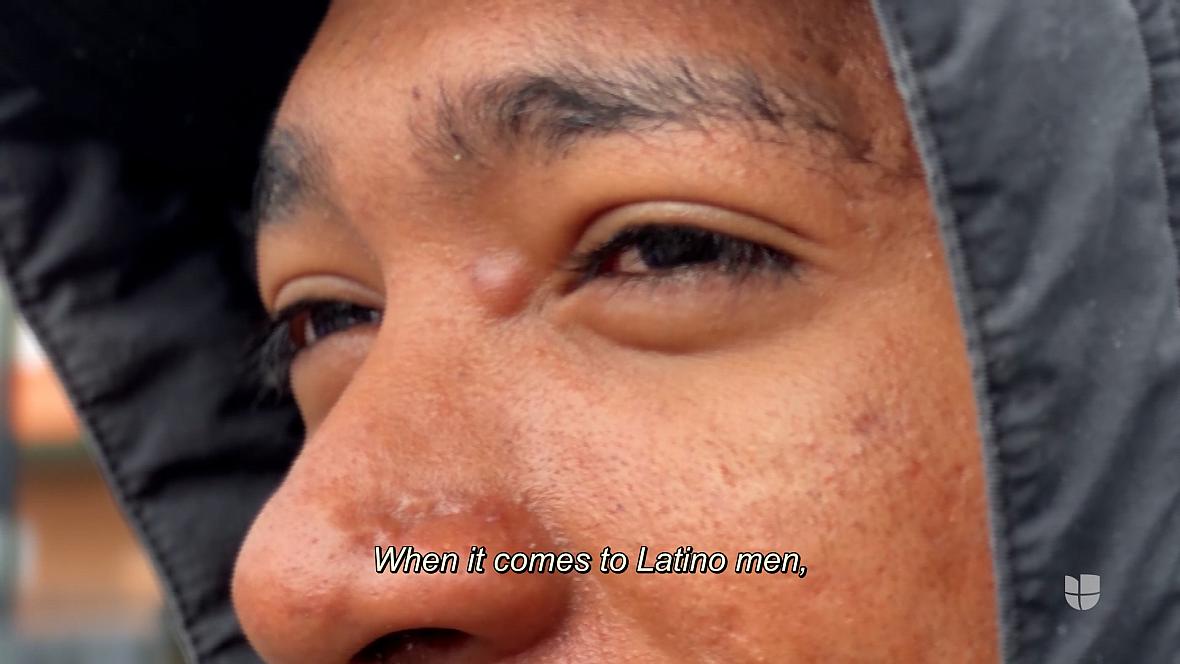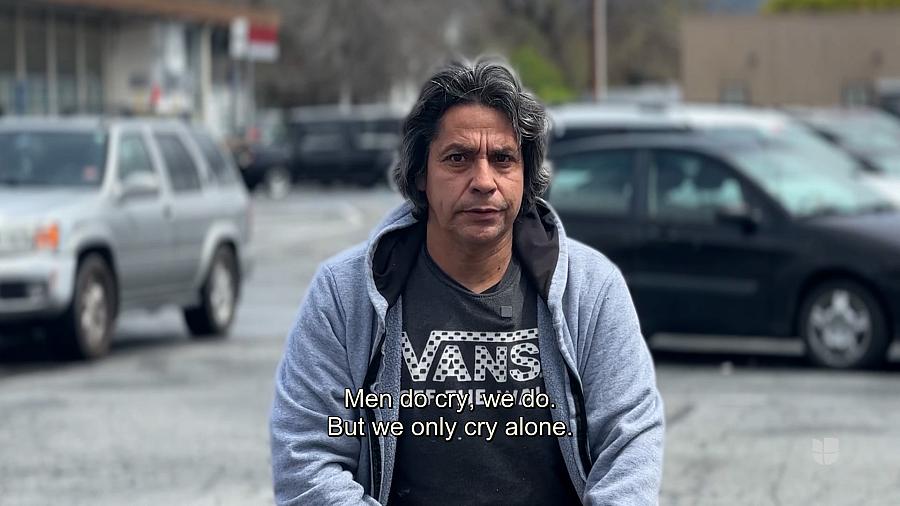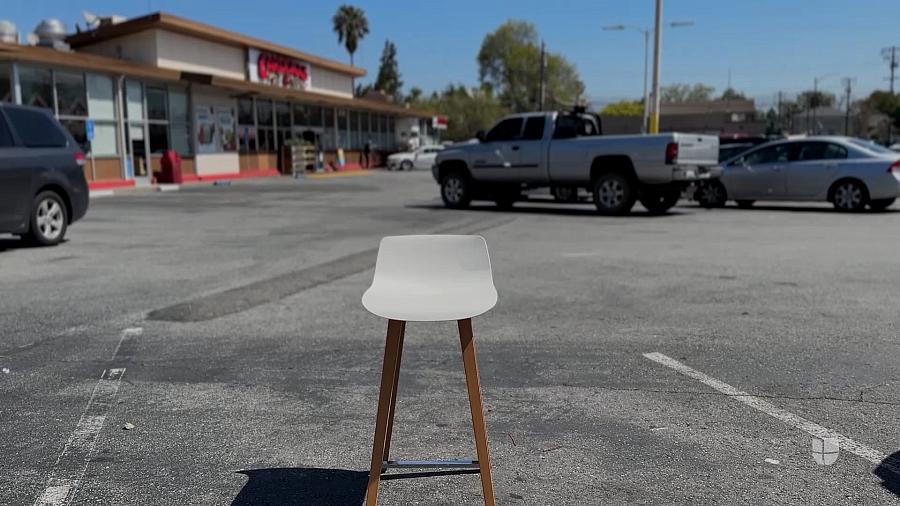Keeping the Silence: Depression Among Latino Men
The story was co-published with Univision 14 Bay Area as part of the 2024 Ethnic Media Collaborative, Healing California.

The death rate from suicide for Latino men was four times the rate for Latino women.
Univision 14 Bay Area
In the United States, 80% of deaths by suicide are committed by men. The suicide rate for Latino men has increased since 2011 climbing from 5.7 per 100,000 people to an alarming 7.9 per 100,000 in 2021. The death rate from suicide for Latino men was four times the rate for Latino women.
Experts have labeled it a silent crisis, a reality that hides behind the armor of being a man. Today we are going to talk openly about men's mental health, without fear and without armor.
VOICES OF RANDOMLY INTERVIEWED MEN ON THE STREET

Man 7: “If you cry, you cry alone.”
Univision 14 Bay Area
MAN 1: You must work hard, improve yourself, give it your all, buy a car and a house.
MAN 2: And you should be able to do it without showing too much of your feelings.
MAN 3: We must be strong.
MAN 4: A man should be a man, he can't stop, he can't cry.
MAN 6: That's a lie.
MAN 7: If you cry, you cry alone.
(The voices distort and Manuel's testimony begins)
SOT MANUEL JASSO - SUFFERS FROM CHRONIC ANXIETY
It was an irrational anguish. I kept telling myself, "Manuel, calm down." It was a distress, like you almost want to cry, but you know you can't, at least because you're the boss, that part I kept holding up as best I could, even though some nights were really bad.
VOICE OVER
Manuel is doing something he has been told not to do. Talk about how he feels. And in his case, he's taking it a step further by doing it on television for thousands of people.
SOT DAYANNA
Why did you agree to give us this interview, Manuel?
Manuel: Part of my hope is that this will help someone. That my daughters boyfriend will see it. My wife told me, whatever you decide to do, they will see it.
VOICE OVER
But it's difficult, he admits, because he faces the social expectations of being a man, being a Latino man, and being macho. That's why he tells me, laughing and a bit nervous, that his grandfather or his father wouldn't do what he's about to do. Admitting that he's not okay.
SOT MANUEL JASSO
Last year, three very important things came together: work problems, health, and personal problems. For me, the indicator was that I lived anxious all day long and I said to myself, this is not me ... Everything started getting worse until I started having panic attacks. I couldn't work and I couldn't sleep. I would sleep for hours and wake up anxious.
DAYANNA: What did your body feel?
MANUEL: The heart was very agitated with anxiety. In fact, several times I had to run around the house because I was so agitated. I couldn't breathe and my heart was beating fast.
VOICE OVER
What Manuel describes — anxiety and depression — is currently experienced by 6 million men in the United States, according to the Anxiety and Depression Association of America. But in the case of Latino men, according to the Department of Health and Human Services, only 1 in 5 men receives help. That's why experts call this a silent crisis.
SOT JULIO MONTERREY - PSYCHIATRIST
Of the adults I see, only 30% are men.
DAYANNA ON CAM
And this silence takes a devastating toll. Even though women experience more mental health issues and even register more suicide attempts, more men die by suicide. They do it in a more violent manner and therefore more effectively. According to the World Health Organization, 80% of suicides in the world are committed by men. And Latino migrants living in the U.S. are not exempt from this harsh figure.
SOT JULIO MONTERREY
Unfortunately, most come with a more advanced clinical picture. Unlike women who present sooner, men tend to endure as much as possible.
VOICE OVER
Manuel endured it for months, trying to be strong. Until he couldn't anymore.
SOT MANUEL JASSO
I remember thinking very clearly and saying: I can't feel like this every day for the rest of my life, I can't live like this and that's when you start thinking. That's why there are people who kill themselves. Who would want to live like this for the rest of their life? No one. Impossible, it's horrible. You start thinking about it not as a solution, but as a way out.
A way out that more and more people are turning to. Suicides have been spiking up in the United States. In 2022, the highest number of suicides were recorded since 1941. According to the Center for Diseases Control, 49,500 people took their own lives and most of them were men. Suicides increased for every age group other than among individuals between the ages of 10 and 24. The situation is so grave that in 2022, suicide was the second-leading cause of death for adolescent boys and young adult men, as well as for men aged 25 to 44. For all these reasons, the World Health Organization has spoken about the importance of understanding the factors of suicide and analyzing its causes. In addition to traumas, abuses, and mental disorders, economic situations, unemployment, health, and emotional problems can complicate mental health.
SOT DAVID LOPEZ - DEPRESSION PATIENT
Sometimes i wake up screaming.
VOICE OVER
David lost his job after an illness that ended in the amputation of his leg. Recently he was assaulted by a stranger outside his house. He is also being evicted from his home. He feels that all of this has piled up on him.
SOT DAVID LOPEZ
There are things that block you because you can't pay attention because your mind is blocked.
VOICE OVER
Immigrant and undocumented Latino men are even further from receiving help. And it's because, although the stigma barrier is powerful and can affect all men, there are other obstacles that keep them away from help.
SOT ELISEO PEREZ ESTABLE - DIRECTOR OF THE NATIONAL INSTITUTE ON MINORITY HEALTH AND HEALTH DISPARITIES
My name is Eliseo Perez Estable and I am the director of the National Institute on Minority Health and Health Disparities.
VOICE OVER
The difficulties Latinos face in accessing health services are multiplied when it comes to mental health.
SOT ELISEO PEREZ ESTABLE
Primary care is covered by insurance, but often coverage for psychological consultations is limited. No one is accepting new patients, even in California.
VOICE OVER
A private consultation with a psychiatrist could cost up to $600, Doctor Monterrey tells us. That's why many people don't seek help.
SOT DAVID LOPEZ
I did have psychological therapy, but I think spirituality helps me more.
VOICE OVER
The next step is finding a specialist who speaks Spanish, the waiting list is huge. But besides all this, men really struggle to identify that something is wrong.
SOT ELISEO PEREZ ESTABLE
Patients don't come and say I'm depressed, the patient says I have chest pain, I'm very fatigued. Because the patient is looking for medicine and always thinking more about the physical than the mental and the reality is that the brain is connected to everything.
VOICE OVER
That's why men are also more prone to addictions.
SOT JULIO MONTERREY
Even if they don't want to, they seek treatment and unfortunately, they find it in substances, in alcoholism, for example. As a result, they not only suffer from depression but also from substance abuse.
VOICE OVER
Women also suffer the consequences of the silence they keep, as they increase the risk of partner violence. And in the case of Latinos living in the United States, another factor is added, they are immigrants, a vulnerable group, usually without migratory stability or guarantee of old age future. That's why when Latino men reach a certain age and they lose the physical strength with which they used to work, they are even more at risk of suffering from depression. But can we do about this issue if there are few specialists and care is costly?
SOT ELISEO PEREZ ESTABLE
Moderate depression, non-serving, can be treated with medications with the family doctor.
VOICE OVER
That's part of the hopeful future, because since 2024, undocumented migrants also have medical care in California, which includes free psychological care. In addition, with Proposition 1, more investment in mental health was promised, and improvements are also expected with the Latinos Mental Health bill presented by senator Alex Padilla in 2023. Additionally, there is the National Suicide Prevention Hotline 988 and the efforts of several counties to train therapists who speak Spanish and enable help through calls or text messages.
SOT ELISEO PEREZ ESTABLE
There are also self-help ways like looking for pleasant activities, walking, watching movies, being with friends.
VOICE OVER
Manuel does all of this. He's been in therapy with a specialist for a year, he exercises, listens to music, goes for walks in the morning, and even has a dog — everything necessary to feel better, but the most important, he says, is to talk.
SOT MANUEL JASSO
When you have a problem, think about it, but not alone.
VOICE OVER
His wife is his refuge.
SOTS -DOUBLE SHOT
DAYANNA: Do you think you could have done it without asking for help?
MANUEL: No, No. I think it's impossible to get through it alone.
DAYANNA: Is that anxiety gone now?
MANUEL: Yes. It's gone.
DAYANNA: And those thoughts are gone now
MANUEL: Yes, they're gone.
VOICE OVER
Viewed another way, the data we've reviewed today tells us that even if you haven't experienced a mental health condition, it's highly likely that right now, some man you're close to, a loved one, or a co-worker is going through this and in silence. While suicide is the most obvious and evident indicator, according to the National Institute of Health, nearly half (46%) of Latinos in the United States have reported anxiety and depression.
SOT JULIO MONTERREY
Many people say that men don't go for mental health evaluations because they have to be men. They can't cry, they can't feel sadness, and perhaps we should change the definition of being a man. But when a man comes into my office, if I say to that person, let's change what it means to be a man that won't work. What I focus on is how the person feels, what's bothering them, that sadness, that deep discomfort, it's a deep and painful void. We'll work on that and with time that person will change their concept of what it means to be a man — that a man can get sick with depression just as he can get sick with pneumonia.
VOICE OVER
Even for us, the exercise of talking to random men on the street left us with a lesson.
SOT DAYANNA:
When was the last time someone asked you how you feel?
Man 1: Umm, I ask myself that.
VOICE OVER
For us, it only took a chair and a question for the silence to end.

For us, it only took a chair and a question for the silence to end.
Univision 14 Bay Area
SOT MAN 2: I used to drink and it brought me down, and through that i also lost my family.
DAYANNA: Didn't you seek help?
MAN 2: Well, no, because i didn't feel sick.
MAN 3: We can't handle everything, it's too heavy. Suddenly, we realized that perhaps the armor is already open.
SOT MAN 4: It's very important that men talk about their feelings.
MAN 5: I've cried too, it's not shameful, I've cried. The soul rests when you cry.
MAN 2: It's not convenient to keep quiet because it will always be there, it's better to let it all out, you'll always be there with the knot.
VOICE OVER
And probably in the midst of that silent struggle that millions of men are going through right now, a simple gesture from us could help, the gesture of listening. Let’s emphasize this last point, because while suicides are related to mental health conditions, the crises the world is going through, post-pandemic and other external factors, are also important causes. In fact, more than 50% of those who committed suicide in the United States in 2022 did not have a diagnosis of mental illness. That's why today, we not only wanted to put numbers to this problem that is hitting this group that avoids talking about their emotions, today we also wanted to put faces to it. Thanks to those men who were willing to talk to us because they are opening a door that has been closed for a long time. They are demystifying male mental health.
This project is supported by the USC Annenberg Center for Health Journalism, and is part of “Healing California,” a yearlong reporting Ethnic Media Collaborative venture with print, online and broadcast outlets across California.

